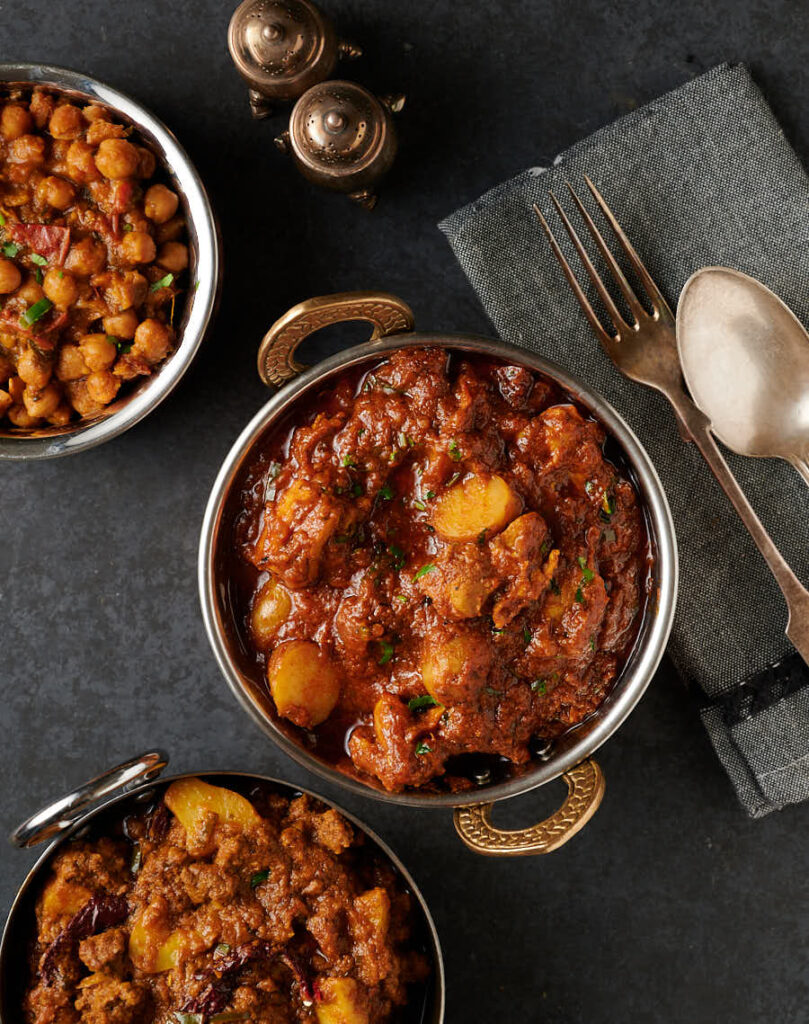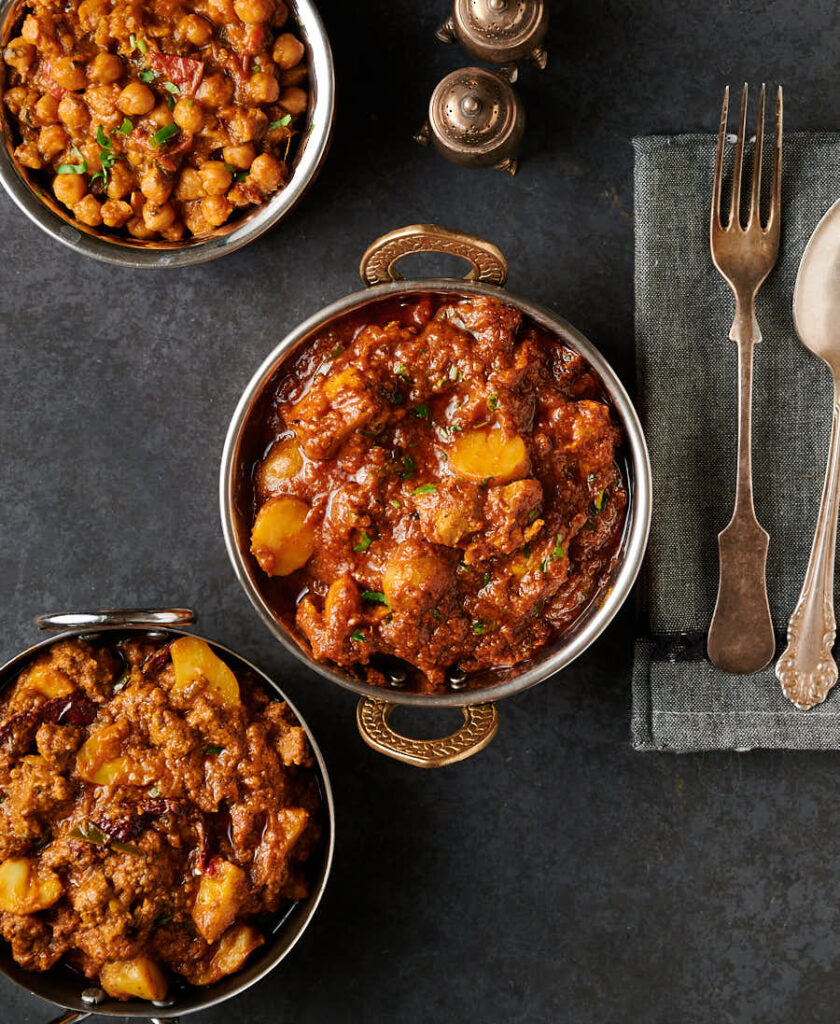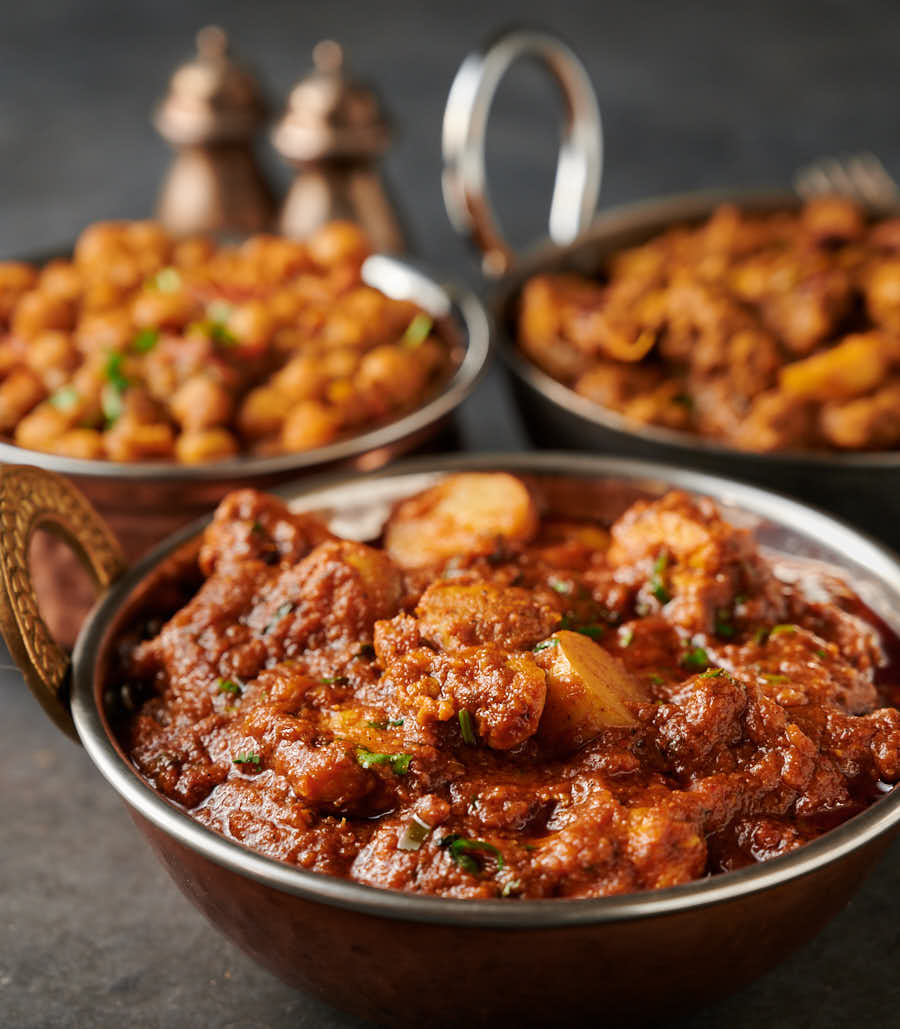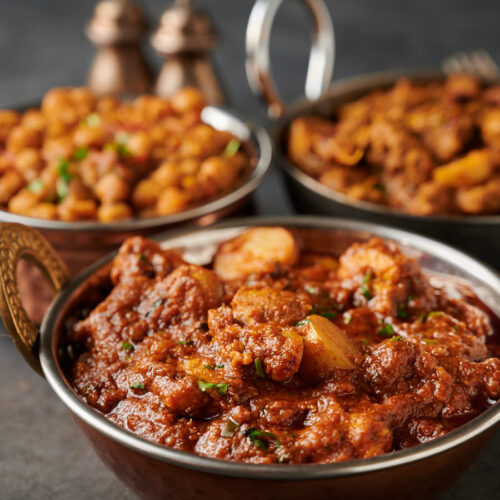Want something different? Something that isn’t the same 10 curries you make over and over? Aloo chaat chicken curry is one of the tastiest Indian curries you have never heard of.
Aloo chaat chicken curry doesn’t exist on a menu anywhere that I’m aware of. I made it up. It’s different from the run-of-the-mill curries you see on almost every Indian restaurant menu.
And what makes it special is the chaat masala. That really gives it a distinctive tang. If you’ve never had chaat you have no idea what I’m talking about.
But if you have, you know. I’m loving the chaat masala these days. Different. In a funky, good way.

Aloo chaat chicken curry is a take on Indian street food
Think fried potatoes are tossed in a mix of spices, green chilies and maybe some lemon or lime juice. Sound good? Aloo chaat. Indian street food.
That’s the inspiration here. Takes the flavours of aloo chaat and runs with it. Street food becomes restaurant curry.
The big flavour here comes from the chaat masala. Without it, it’s just another curry with potatoes and chicken. I’m not saying that is a bad thing. I’m saying it can be better. Something special.
Your choice of chaat masala matters. The key ingredient in chaat masala- the one that really makes it – is black salt. It’s important. Gives it the distinctive tang.
Some chaat masalas have it. Some don’t. Not sure why that is. Read the ingredients and make sure the one you get has it. Or you can make chaat masala yourself.
If you can’t find a chaat masala with black salt you can just buy some at your Indian grocer.Black salt is kala namak in Hindi. Just ask for it. It’s cheap. Just add a pinch of it in when you add your chaat masala. Easy fix.

This is cooking Indian restaurant style
It’s a pretty straightforward and follows the Indian restaurant technique exactly. Do yourself a favour and read that post first. There are pictures and a video to help you understand.
Prep your ingredients. Make your curry base. Have some heated and ready to go. Pre-cook your meat. Measure out your ingredients. Put on some old clothes – the curry sputters.
Make this aloo chaat chicken curry as written. Or make it with lamb. That works too. Or use chickpeas. Makes a great potato curry. Lot’s of possibilities.
Restaurant style aloo chaat chicken curry. May not be the most common dish on restaurant menus but it should be.

restaurant style aloo chaat chicken curry
Ingredients
The spice mix
- 2 tsp hot madras curry powder or use indian restaurant mix powder if you don’t have any madras curry powder
- 1 tsp kashmiri chili powder or 1/4 tsp cayenne mixed with 3/4 tsp paprika
- 1 tsp kasoor methi – dried fenugreek leaves
- 1/2 tsp kosher salt
The curry ingredients
- 3 Tbsp oil
- 1/2 large onion minced
- 1 green chili seeded and minced
- 1 Tbsp garlic/ginger paste – recipe link below
- 1 Tbsp tomato paste with enough water to dilute to the consistency of pasatta
- 15 oz curry base – recipe link below
- 10-12 oz pre-cooked chicken
- 8 small new potatoes – pre-cooked
- 1 1/2 tsp chaat masala powder available at any Indian grocery
- 1 Tbsp chopped fresh coriander leaves
- Juice of 1/6 lemon – around 1 tsp or so
Instructions
- Make the spice mix.
- Dilute the tomato paste with enough water to get to the consistency of passata.
- Heat your frying pan (don’t use non-stick) briefly over medium heat. Add the oil.
- Add the onions and stir constantly until the edges of the onions start to brown. This takes about a minute or two, depending how hot your pan is. Mix in the green chili and cook another 30 seconds or so.
- Next comes the garlic ginger paste. Add it into the pan and cook it, stirring constantly, until it stops sputtering.
- Turn down the heat and add the spice mix. This is the critical step. Stir it constantly for 30 seconds. If it starts to darken lift the pan off the heat. You want the spice mix to cook in the oil but not burn.
- Turn the heat up to medium high. This is important. The heat is what makes the curry base do its magic. Gives the curry it's Indian restaurant flavour. As you become more comfortable with this technique try pushing it. Add the diluted tomato paste and stir until bubbles form (the oil will likely separate). This takes around 30 seconds to one minute depending on the heat.
- Add 3 oz of curry base. Stir until bubbles form (little craters really), around 30 seconds. Think lively boil. Watch the edges of the pan. The curry can stick here. Sticking is OK. Just scrape it back into the base. Burning is bad.
- Now add 6 oz of curry base and stir briefly. Let it cook until the bubbles form again. This takes 1-2 minutes.
- Add the rest of the curry base and let cook until the bubbles form. Turn the heat down to low and add the chaat masala powder, pre-cooked chicken and potatoes.
- Let the curry simmer for about 5 minutes. If it gets too thick add a bit more curry base. Don’t add water.
- Mix in the lemon juice and coriander leaves.
- Garnish with a bit of chopped fresh cilantro and serve.


